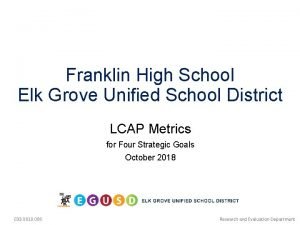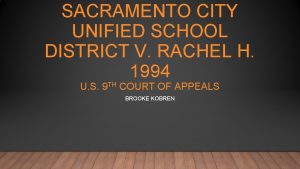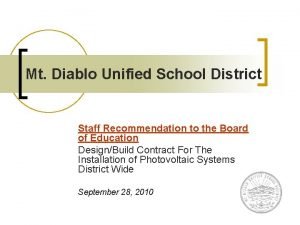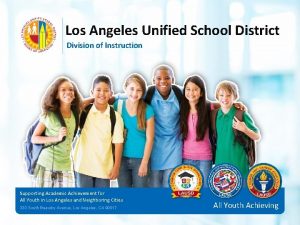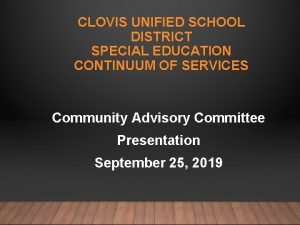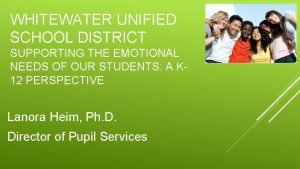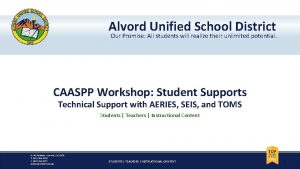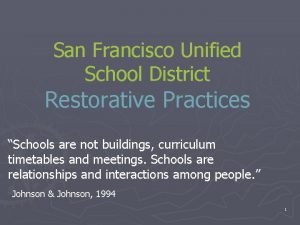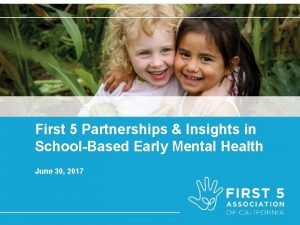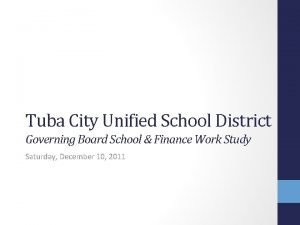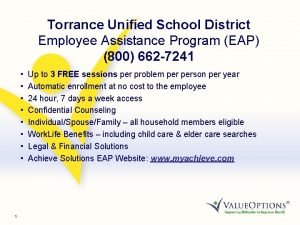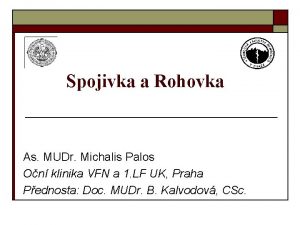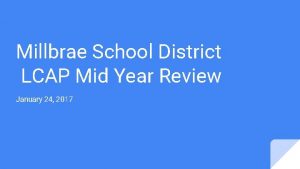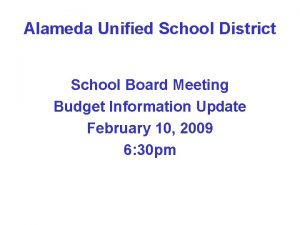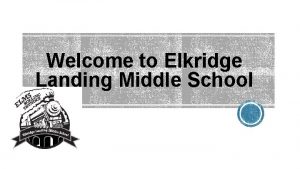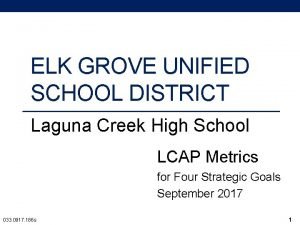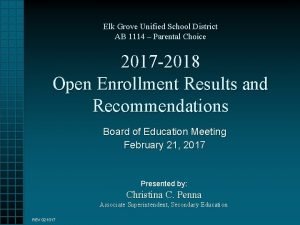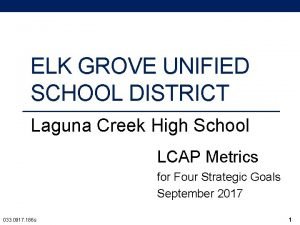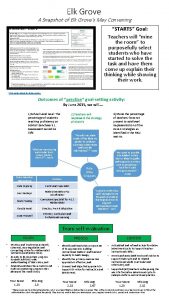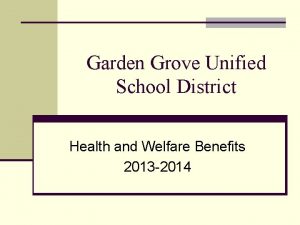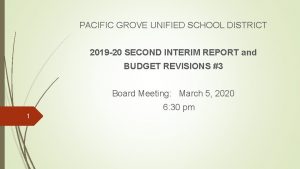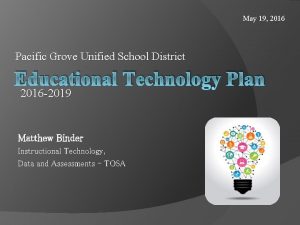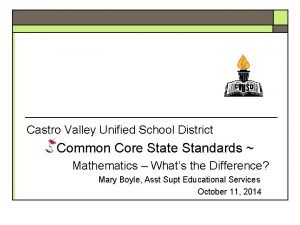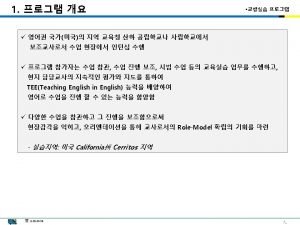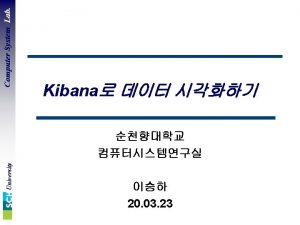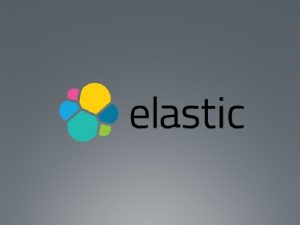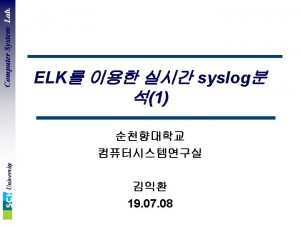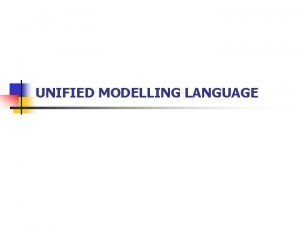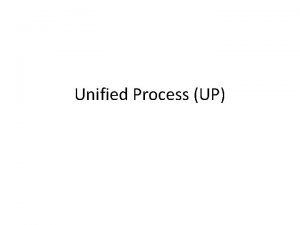August 12 2015 Elk Grove Unified School District






























- Slides: 30

August 12, 2015 Elk Grove Unified School District

“The real object of education is to give children resources that will endure as long as life endures; habits that will ameliorate, not destroy; occupation that will render sickness tolerable, solitude pleasant, age venerable, life more dignified and useful”

What does least restrictive environment (LRE) mean? • Requirement in Federal Law – Students with disabilities receive their education, to the maximum extent appropriate with nondisabled peers • Special education students are not removed from regular classes unless, even with supplementary aids and services, education in regular classes cannot be achieved satisfactorily • [ 20 U. S. C. Sec 1412(a)(5)(A); 34 C. F. R. Sec 300. 114

Mainstreaming • Refers to placement of a student with disabilities into ongoing activities of regular classrooms so that the student receives education with nondisabled peers – even if special education staff must provide supplementary resource services

Integration • Includes mainstreaming into regular classes and access to, inclusion, and participation in the activities of the total school environment. • Placement in structured and non-structured opportunities to interact with nondisabled, age –appropriate peers. • Activities such as lunch, assemblies, clubs, dances or recess. • Participate in selected activities in regular classes - such as art, music, or computers • The student should also be able to participate in regular classes with modifications and adequate supports. • Also refers to placement of students in special education classes on integrated school sites

Full Inclusion • Total integration of a student with disabilities into the regular education program – with special supports. • In full inclusion, the student’s primary placement is in the regular education class. • The student is actually a member of the regular education class • The student need not be in the class 100% of the time but can leave the class to receive supplementary services such as speech or physical therapy.

Inclusive Education Halvorsen/Neary 2001 • According to its most basic definition, means that students with disabilities are supported in chronologically age-appropriate general education classes • In their home schools • Receive specialized instruction delineated by their IEP within the context of the core curriculum and general class activities

Inclusive Education The City University of New York 1995 • Providing to all students, including those with significant disabilities: • Equitable opportunities to receive effective educational services with needed supplementary aids and support services • In age appropriate classrooms • In their neighborhood schools

Facts • The district may not make placement decisions based solely on factors such as: • Category of disability • Severity of disability • Availability of educational or related services • Availability of space • Administrative convenience

Facts continued • The IEP must specify the supplementary aids and services necessary to ensure a student’s participation in the regular education program [20 U. S. C. Sec. 1414 (d)(1)(1)(A)(i)(IV) • Such arrangement apply to any class or extracurricular activity in which the student might participate. [34 C. F. R. Secs. 300. 117 & 300. 320(a)(4)(ii) • Examples: science, geography, physical education, art, music and vocational education • The IEP is binding on the school district, therefore both special and regular education personnel must follow its provisions

Facts continued • As a general education teacher, you are required by law to have knowledge regarding the contents of the IEP for each special education student enrolled in your class, and you are legally obligated to implement any portions of an IEP that apply to you. • Its imperative that the general education teacher participate in the IEP team meeting in order to provide input

Modifications and Accommodations

Modifications • A change in what a student is taught or expected to learn. The term is used in IEP’s and 504 Plans • Complete fewer or different homework problems than peers • Write shorter papers • Answer fewer or different test questions • Create alternative projects or assignments • Learn different material • Get graded or assessed using a different standard than the one for classmates • Be excused from particular projects Accommodations • A tool or procedure that provides equal access to instruction and assessment for students with disabilities: • Listen to audio recordings instead of reading text • Learn content from audiobooks, movies, videos and digital media • Work with fewer items per page or line and/or materials in a larger print size • Have a designated reader • Hear instructions orally • Record a lesson instead of taking notes • Another student sharing class notes • Given an outline of a lesson • Use visual presentations of verbal materials

Family Education Rights and Privacy Act of 1974 FERPA

FERPA • Any record that contains personally identifiable information that is directly related to the student is an educational record • Records: student files, databases kept in storage devices such as servers or recordings • Faculty notes kept exclusively by the maker of the records that are not accessible or revealed to anyone else are not considered educational records and therefore fall outside of FERPA disclosure • Allows health care professionals treating in the school environment to discuss the student with teachers, counselors, nurses, and any others who may be involved in the direct education of the student

Let’s Compare Health Insurance Portability and Accountability Act (HIPAA) • Protections and privacy of medical information (1996) • Schools were initially included in the drafts of HIPAA regulations published prior to December 28, 2001 • Final Rule exempted school health providers because FERPA is in place (Department of Health and Human Services) • Even if the District engages in a HIPAA –covered transaction the actual records maintained for billed services are educational records covered by FERPA Family Educational Rights and Privacy Act (FERPA) • Each year District must establish written policies regarding student records and inform parents • Parents are guaranteed access to their children's educational records when requested • Parents have the right to challenge accuracy of records • Personally identifiable information to third parties is prohibited w/o consent • School not required to obtain consent when shared with staff involved in education, school attorneys, special ed. providers or for child find purpose

Application # 1 • A school employee believes that a student presents a serious danger to self or others when he submits a disturbing essay for an assignment. Both the HIPAA and FERPA privacy rules permit the disclosure of private health information to a parent or others if the information is released in good faith. • The disclosure must be deemed necessary to prevent or lessen the threat and the release of such information is given only to individuals who could intervene and/or lessen the threat. • Depending on the circumstance, this may include disclosure to law enforcement, family members, the target of the threat and /or others who discloser has a good faith belief can mitigate threat. (U. S. Department of Health 2008)

Application #2 • A physical therapist contracted with the local public school district is billing Medicaid for services provided for a child with cerebral palsy. • The billing should be performed following HIPPA guidelines but the record itself is part of the education record, and subject to FERPA. • Even though the district engages in a HIPPA-covered transaction, the records maintained for billed services are educational records. • The student’s personally identifiable information is protected by FERPA not HIPAA Privacy Rules

Bottom Line • The Family Policy Compliance Office has expressly stated that it “will not fault good-faith decisions even if they turn out, in hindsight, to have been wrong” (Mc. Donald, Family Rights and Privacy Act: 7 Myths-and the Truth. April 18, 2008)

Attendance The IEP Meeting

Who should be at the IEP meeting ? • Parents • Not less than 1 regular education teacher • Not less than 1 special education teacher and the Designated Instructional Services providers D. I. S. providers (related services) • An individual who can interpret instructional implications of the assessment/evaluation results • An local educational agency (LEA/school district) who is qualified to provide or supervise provision of specially designed instruction • At discretion of the parents or LEA other individuals who have knowledge or expertise regarding student and/or related services and whenever appropriate, the student

When an IEP Member May NOT Attend • If the parent and the LEA agree, in writing, that the attendance of the member is not necessary because the member’s area of curriculum or related services is not being modified or discussed • When the meeting involves a modification to or discussion of the member’s area of curriculum or related services if: The parent, in writing, and the LEA consent to the excusal and the member submits, in writing to the parent and the IEP Team, input into the development of the IEP prior to the meeting [34 CFR 300. 321] [ 20 U. S. C. 1414(d)(1)(c)

Statewide The Most Common Complaints

Complaints • Failure to Implement the IEP (34 CFR) section 300. 342(6) • Failure to Implement the IEP Accommodations • Failure to Adhere to Procedural Safeguards: referral to special education, assessments conducted, IEP meeting held • Failure to Include all Required Members in the IEP team (34 CFR) section 300. 344

Initiating the IEP Process

Getting Started – The New Road to Hana • Expressed concern regarding the student by anyone • Referral to Student Study Team – Modification in the General Education setting or • Referral to Special Education – Child has a documented and identified disability • Within 15 days • Assessment Plan developed for parent approval • Within 15 days • Parent signs and returns the plan – District has 60 days to complete the assessments and convene an IEP meeting and develop an IEP which is implemented “as soon as possible”

What districts can do Teacher – Parent Collaboration

Assigning Roles • Get specific training on collaboration and team building. Invite families to these trainings. • Create an action plan which will address how to increase and improve communication among the IEP team • Encourage parents to bring advocates to meetings • Provide a list of advocates or volunteer parents to further encourage parents to bring advocates • Assign a liaison to be the point person for parent questions and to ensure the parent is given the time and opportunity to communicate with the team • Be flexible to parent visitation and observation to eliminate feelings of suspicion and uneasiness

• Change the environment of the meeting …. use a round table or a different room • Develop a written agenda for every meeting. Send it to parents prior to the meeting and ask for their feedback • Be sure to address parent concerns in meeting • Do I really believe that parents are my equal, in fact, are experts on their child? • Do I show the same respect for the value of parents’ time as I do for my own? • Do I speak plainly and avoid medical, psychological or social work jargon? • Do I actively involve parents in the establishment of a plan of action or treatment and continually review the plan with them? • Do I share information with other professionals to insure services are not duplicated and that families are not running in circles.

As a Professional You have the right • To be treated with respect • To be true to your values • To disagree and be honest with parents
 Elk grove regional scholarship foundation
Elk grove regional scholarship foundation Franklin high school egusd
Franklin high school egusd Elk grove village youth baseball
Elk grove village youth baseball Lodi summer school
Lodi summer school Sacramento city unified school district v. rachel h
Sacramento city unified school district v. rachel h Humboldt unified school district
Humboldt unified school district Abc unified school district
Abc unified school district Medford unified school district
Medford unified school district Abc unified school district
Abc unified school district Clovis adults school program
Clovis adults school program Abc unified school district
Abc unified school district Alvord unified school district
Alvord unified school district Sfusd restorative practices
Sfusd restorative practices First 5 alameda
First 5 alameda El segundo unified school district
El segundo unified school district Clever selma unified
Clever selma unified Lodi usd board meeting
Lodi usd board meeting Tuba city unified school district
Tuba city unified school district Torrance unified school district board meeting
Torrance unified school district board meeting Palos verdes unified school district
Palos verdes unified school district Abc unified school district
Abc unified school district Oakland unified school district map
Oakland unified school district map Novato school board
Novato school board Musd nutrition menu
Musd nutrition menu Millbrae unified school district
Millbrae unified school district Qde maple
Qde maple Etiwanda school district board meeting
Etiwanda school district board meeting Aeries alvord unified school district
Aeries alvord unified school district Alameda school board meeting
Alameda school board meeting Abc qu
Abc qu Elkridge landing middle school
Elkridge landing middle school

